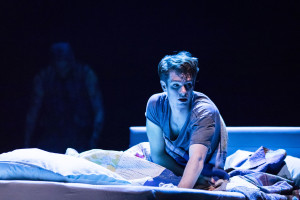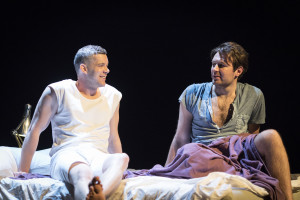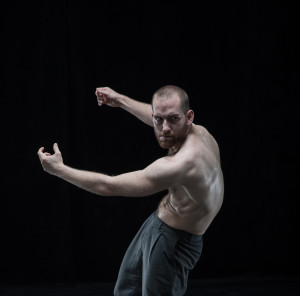by timbaros
 It’s seven and a half hours long, and it’s shown in two parts, but Angels in America: A Gay Fantasia on National Themes is well worth a watch.
It’s seven and a half hours long, and it’s shown in two parts, but Angels in America: A Gay Fantasia on National Themes is well worth a watch.
Calling it epic does not even describe the show. Now playing at the National Theatre, it is monumental, larger than life, phenomenal, engrossing, but it is in no way too long or too boring – sure it may be a bit complex, but it’s first class theatre. And both parts of the production – Millennium Approaches and Perestroika – really do need to seen together. And the cast in this current production is top notch – actors you might not be able to see in such a production again in your lifetime. But more on the cast later.
Unfortunately Angels in America is totally sold out – it’s been sold out since tickets went on sale, and calling it the hottest ticket in town is an understatement (the upcoming Hamilton may come close, but Angels is in limited run, only up until August 19th). So If I were you, I would do anything to get a ticket. But more on that later.

Angels in America has won almost every theatre award up for grabs. Written in 1993 by Tony Kushner, it’s won the Tony and Pulitzer Prize awards, and both parts were performed in London in the early 90’s. What is it about? Well, first and foremost it’s about AIDS in New York in the 1980’s – that horrible decade when friends were dying right and left, dissappearing only never to return. There was no cure, and when people started to see purple lesions on their skin, they knew that it was all over. But Angels in America is also about so much more. It delves deep into relationships that we have with each other and especially with ourselves, it deals with power, greed, lust, lies, betrayal as well as fantasy, ectasy, religion and last but not least life (notice that I did not mention death). The show is complex only in that it goes off into the deep end at times for the necessity of one of the characters. Angels is also still very timely, as it touches on immigration and discrimination based on heritage – themes we are seeing first hand in the much changed political climate that we now live in.
Andrew Garfield is Prior Walter – and he’s got AIDS. He’s goodlooking yet very thin, and has the tell-tale signs of the disease (Kaposi’s Sarcoma). James McArdle is Louis Ironson, his boyfriend who’s having a hard time dealing with Prior’s illness. Then there’s Joe Pitt (Russell Tovey), who is married to Harper Pitt (Denise Gough). The Pitt’s are Mormons from Seattle and live in Brooklyn. Harper Pitt has problems, she’s agoraphobic and has hallucinations. Joe, a clerk in a law office, is deeply-closeted.
Then there is Roy Cohn (Nathan Lane), a notorious ruthless lawyer who happens to be gay but doesn’t quite believe it himself and definitely doesn’t want anyone to know this. So for over seven hours we go on a ride with these characters as Angels in American puts them, and us, through a rollercoaster of emotion and drama. Louis is unable to care for Prior and walks out on him at the moment that Prior needs him most. Louis strikes up more than a casual friendship with Joe as they both work at the same law firm. Meanwhile, Joe, who becomes more than a bit friendly with Cohn his mentor, eventually falls in love with Louis. Meanwhile, Prior (and eventually Cohn) are taken care of by nurse Belize (Nathan Stewart-Jarrett). But alls not right in Prior’s life – he’s seeing angels, angels that are trying to tell him a message, angels that are a response to his illness, yet there’s not much these angels can do for him except only to be by his side (or to fly over him)……they’re helpless just as much as he is. There’s also a crisis in the Pitt home – Joe’s mother sells her house in Utah and goes to Brooklyn to look for her son who has just announced to her that he is gay. And Cohn can’t accept the fact that he’s got AIDS – he informs his doctor that it’s liver cancer that he’s got. And Belize turns out to be the real angel in the show – taking care of the dying, the ones who don’t accept the fact they’ve got AIDS and the ones who are way too young to die of AIDS.
Angels in American deals with a dark time in gay history – the AIDS plague. Conservative President Ronald Reagan didn’t help matters by doing nothing about the disease, Rock Hudson had just died, and the stigmatisation of the disease pretty much erased all the gains that the homosexual community had achieved in the late 1960’s and 1970’s. But in this retelling, and for those of us old enough to be around where all this actually happened, it takes us back to the time when there was nothing we could do for our friends dying of the disease but to just hold their hands and watch them die. And Angels in America takes us back to those horrible time. It’s a credit to the story and the production that the performers excel in their roles and take it to the next level. Garfield has a field day playing Prior – he’s in agony because he’s dying and because Louis has left him – and Garfield gives it his all and succeeds enormously. Lane was made to play Cohn – caustic yet not a bit remorseful, even after the ghost of Ethel Rosenburg practically stands over him waiting for him to die. Lane is just simply superb. Tovey – in his biggest stage role yet – doesn’t disappoint. His Joe Pitt is vulnerable yet determined to be who he’s supposed to be, and he accidentally falls in love with Louis yet is still in love with his wife, and Tovey is very believable every second he is on stage. Stewart-Jarrett, practically an unknown, holds his own with the acting heavyweights on the stage. His nurse and friend Belize is practically the glue that holds the other characters together – and Stewart-Jarrett does it so sarcastically and beautifully. A star is born. McArdle is adequate – he’s got a lot to do and say and it’s perhaps one of the hardest characters in the show as so much centers around him – and McArdle just about succeeds, but less so Gough as Mrs. Pitt who doesn’t quite wow us as the others do. Other notable performers include Susan Brown as Harper Pitt, Joe’s mother, and especially Amanda Lawrence, who plays the Angel, a nurse, a homeless woman, and a Sister, among others, is there nothing this talented performer can’t do?
Of course, the sets and music are all amazing, and director Marianne Elliott brings it all together in excellent fashion – but it’s all about the acting (and the message) in Angels in America, the message is loud and clear – this show is history in the making and relevant to all of us now, even 25 years after it was written.
The National Theatre is running a ballot for £20 tickets so I urge you to give it a try. There are two ballots left:
Ballot no.’s 4 and 5
Show dates included in the ballot: 11 Jul – 29 Jul and 2 Aug – 19 Aug
Ballot opens at midday on: 26 May and 30 Jun
You’ll need to log-in to your National Theatre account or create an account to register for the ballot, you can do so here:
https://www.nationaltheatre.org.uk/angels/login?destination=node/5066
Also, Angles in America will be broadcast live to cinemas around the UK and internationally. Part One will be broadcast on 20 July and Part Two will be broadcast on 27 July. For more information and to buy tickets, please go here:
http://ntlive.nationaltheatre.org.uk
Photos by AiA Perestroika Production Images (c) Helen Maybanks

 It’s seven and a half hours long, and it’s shown in two parts, but Angels in America: A Gay Fantasia on National Themes is well worth a watch.
It’s seven and a half hours long, and it’s shown in two parts, but Angels in America: A Gay Fantasia on National Themes is well worth a watch.
 The term ‘John’ is a word associated with a man who visits prostitutes. It’s also the name of the central character in a show with the same name.
The term ‘John’ is a word associated with a man who visits prostitutes. It’s also the name of the central character in a show with the same name.




